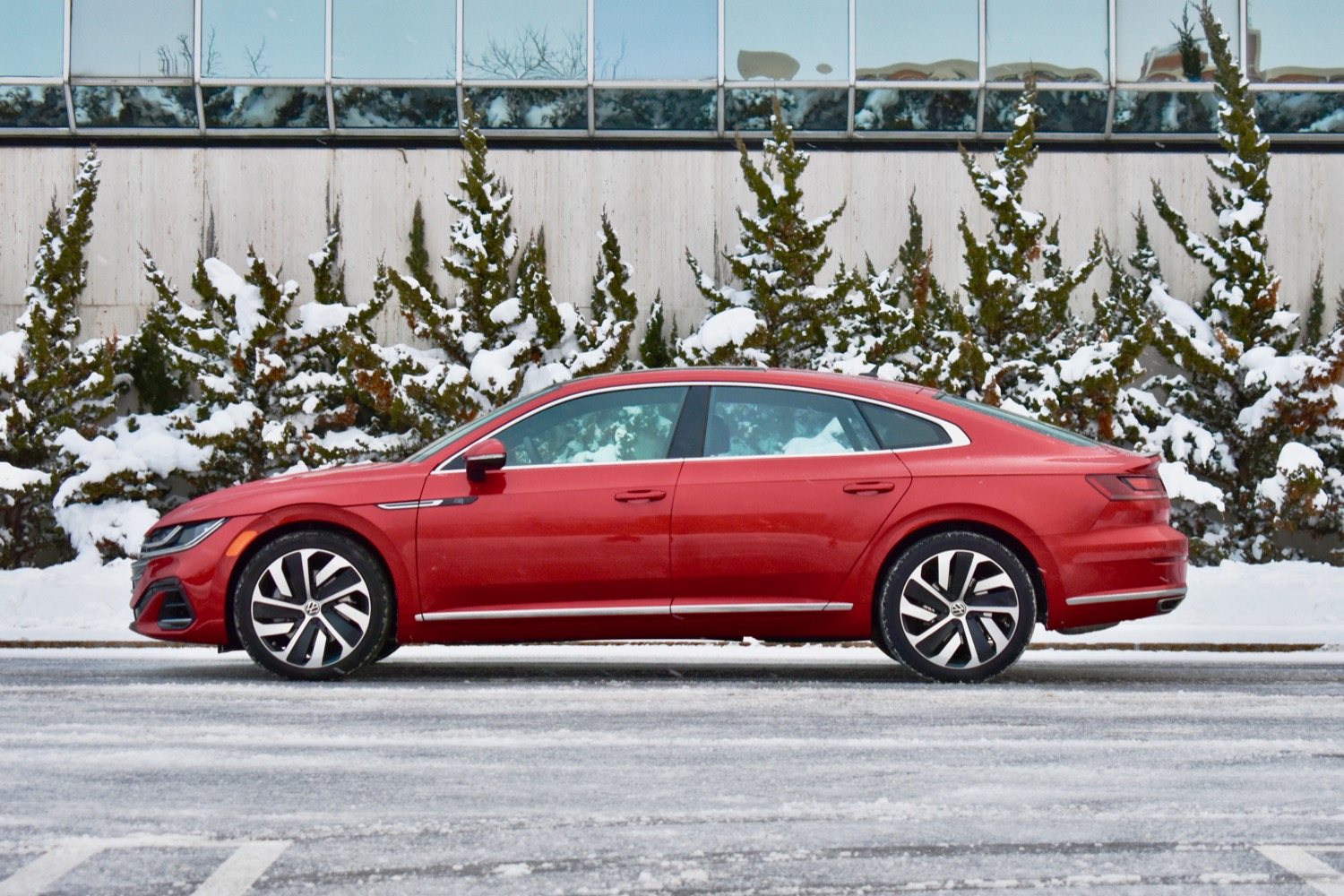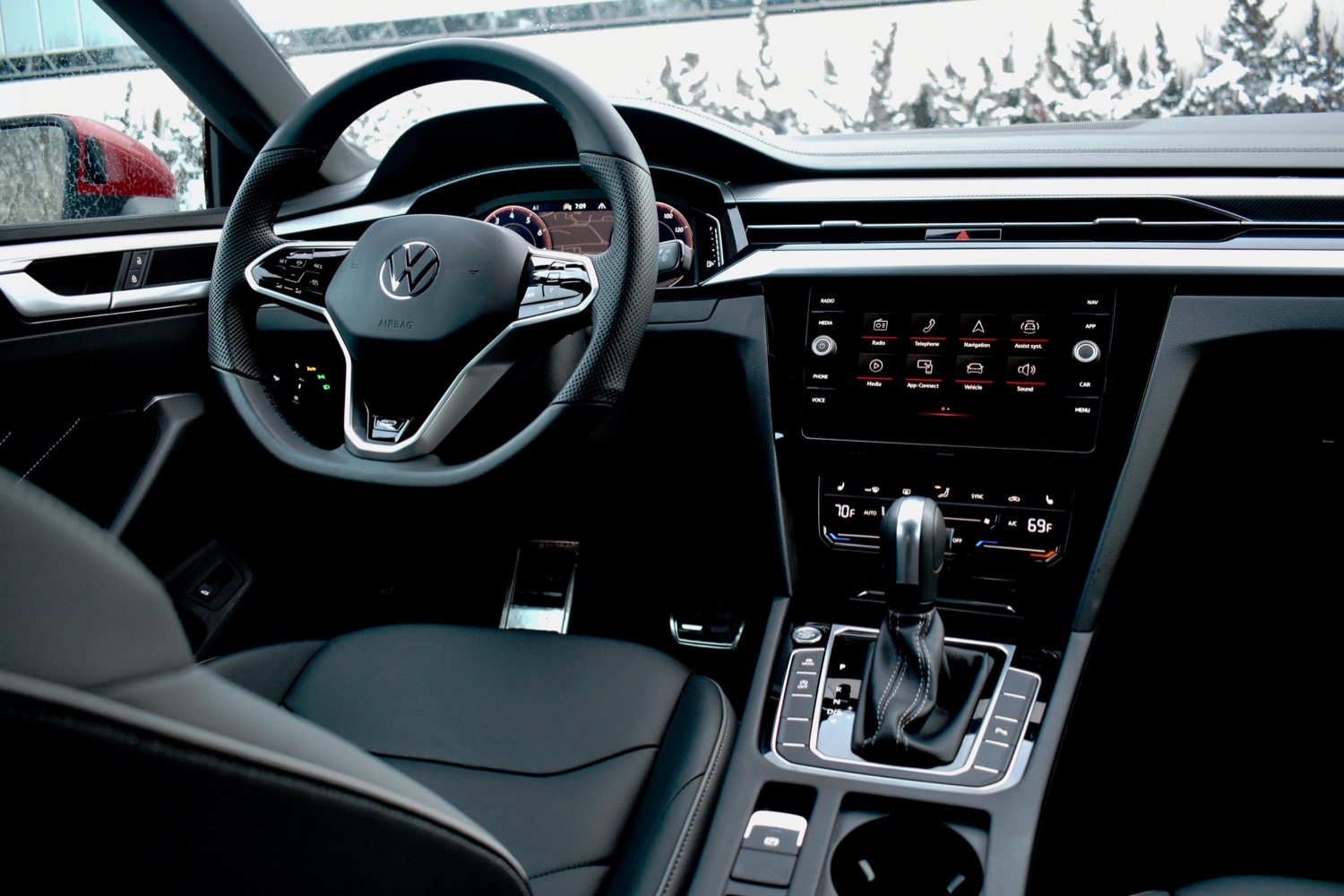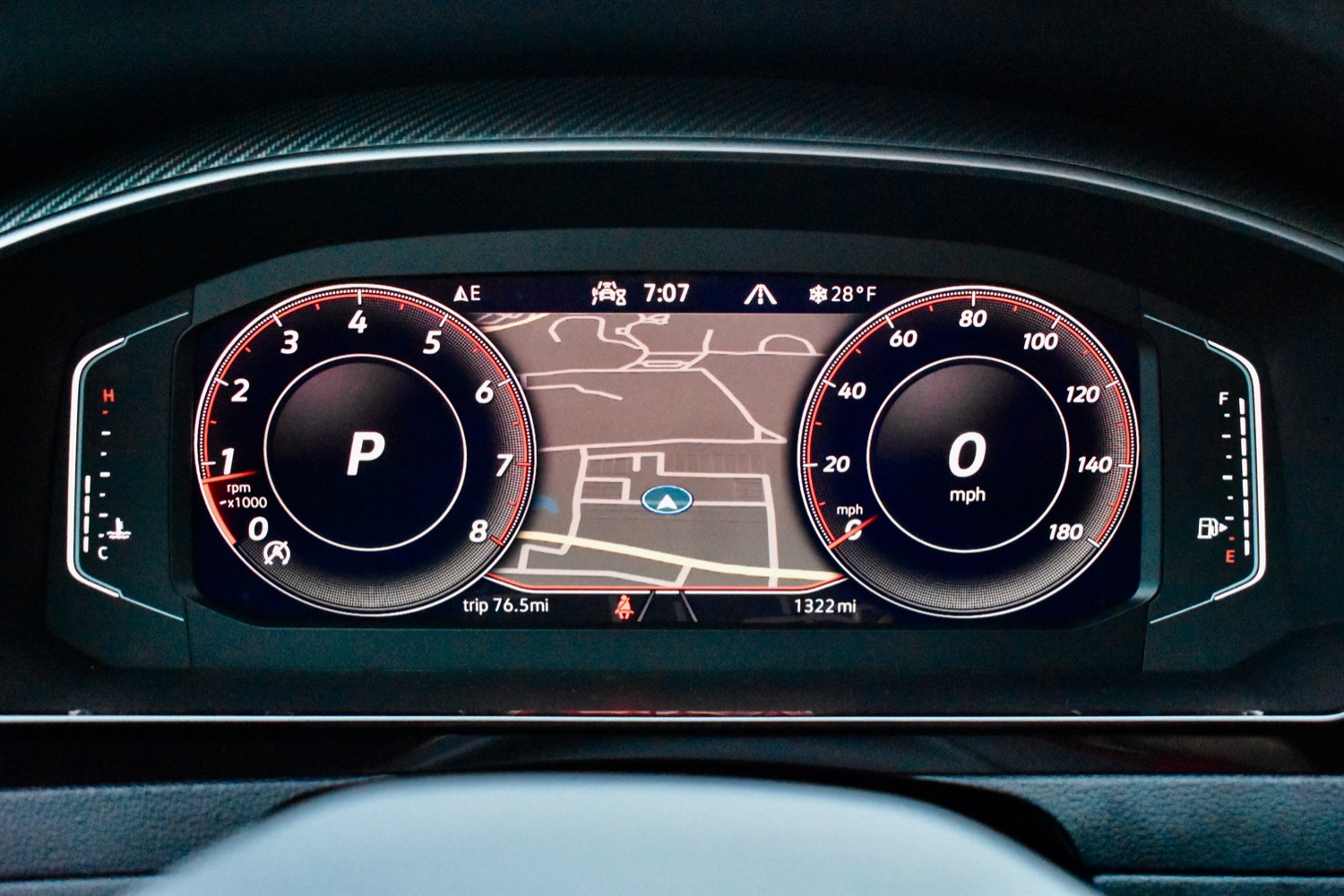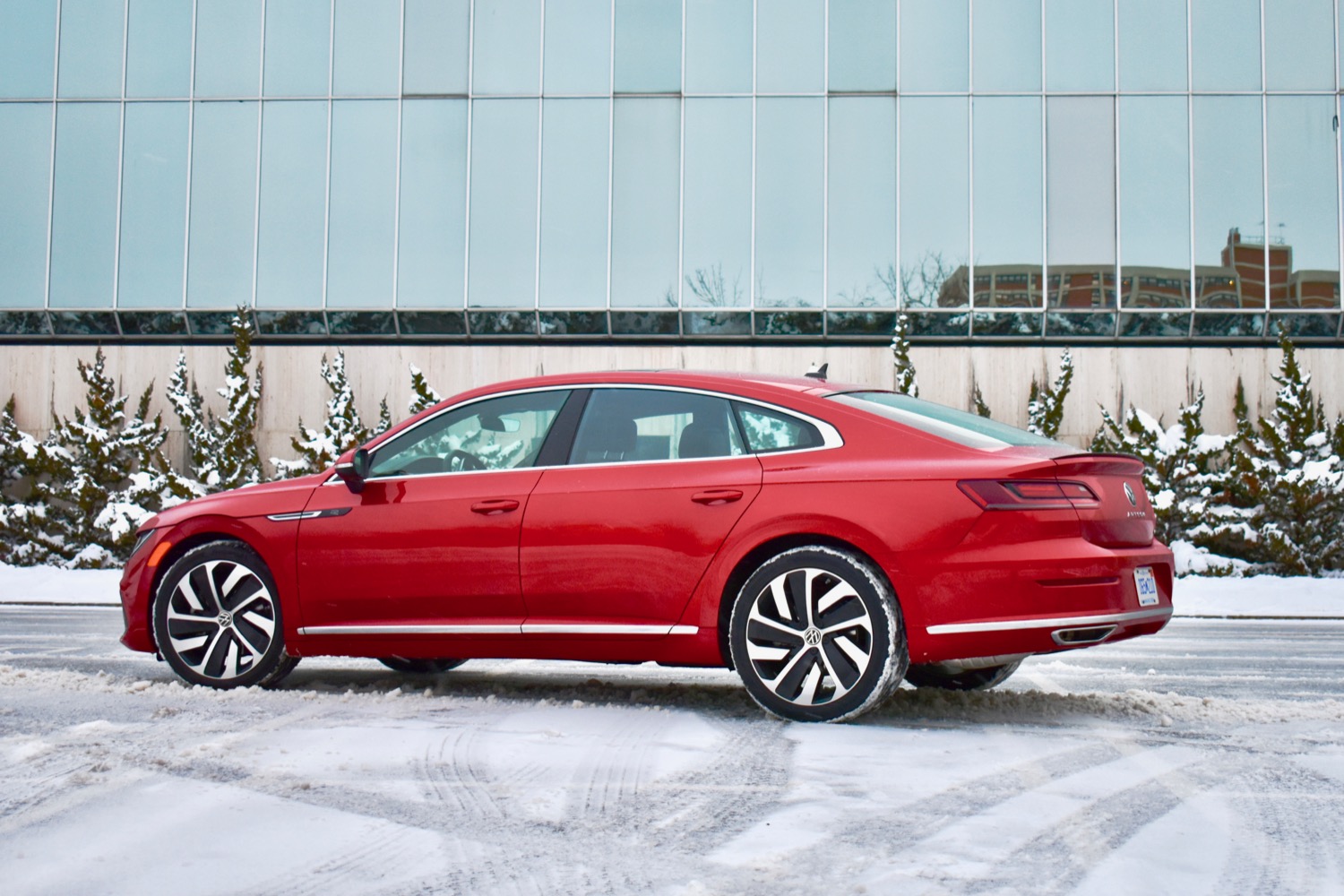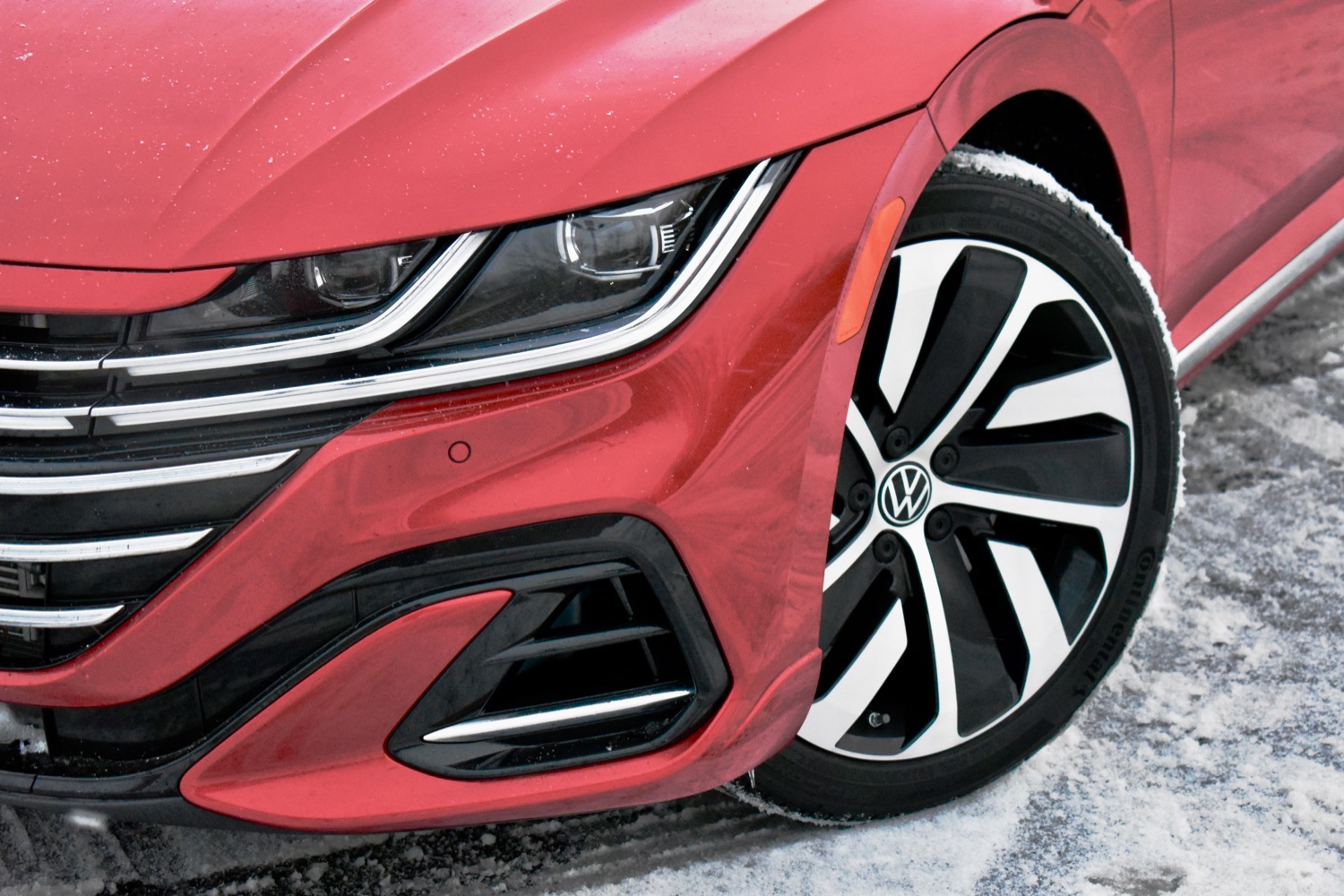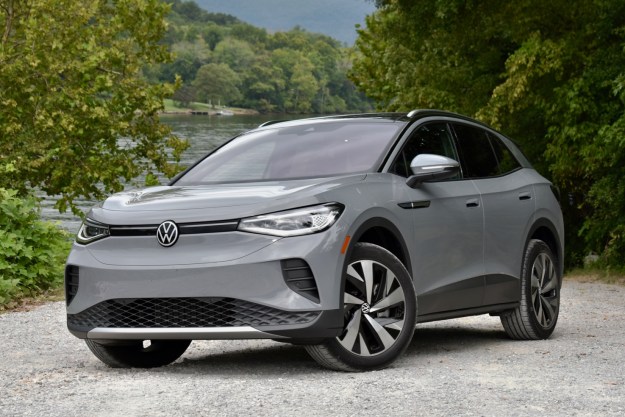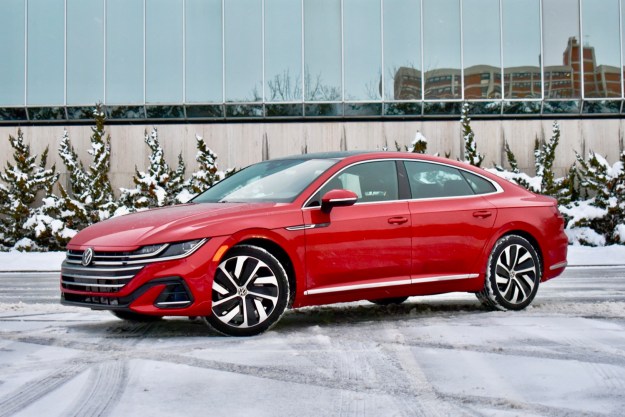
- Looks great inside and out
- Well-equipped
- Wireless Apple CarPlay/Android Auto
- Good ride and handling balance
- Not as sporty as rivals
- Unimpressive driver-assist tech
Volkswagen may be the “people’s car,” but sometimes Germany’s largest automaker tries to go upscale.
That’s the case with the 2021 Volkswagen Arteon. VW’s flagship car, is aiming to deliver a bit more luxury without breaking the bank. VW tries to elevate the Arteon above its lesser models primarily through styling, a more luxurious interior, and a long list of tech features.
The Arteon competes with the Nissan Maxima, Toyota Avalon, and Kia Stinger in the dwindling niche of prestige cars from mainstream brands. However, VW is so confident in the Arteon that it also named the Acura TLX and Infiniti Q50 luxury sedans as competitors. As we shall see, though, the Arteon is missing one key component those luxury brands offer.
VW launched the Arteon for the 2019 model year, but the 2021 Arteon gets a substantial update. It receives the latest MIB3 infotainment system and Travel Assist and Emergency Assist driver aids, plus updated styling and a reshuffled equipment lineup. The base front-wheel drive Arteon SE starts at $38,190, but our test car was a range-topping SEL Premium R-Line model with 4Motion all-wheel drive and a $48,190 base price.
Design and interior
The Arteon’s main selling point is styling. It’s still recognizably a VW, but isn’t as staid-looking as the automaker’s other models. To achieve that look, VW’s designers applied the old Detroit formula of “longer, lower, wider,” giving the Arteon a wider stance, short front and rear overhangs, and a low roof not unlike “four-door coupes” from luxury brands such as the Audi A7 and Mercedes-Benz CLS-Class. Big wheels (18 inches, 19 inches, and 20 inches for the SE, SEL, and SEL Premium, respectively) nicely fill out the wheels wells.
VW gave the Arteon some plastic surgery for the 2021 model year, but you’ll have to look closely to spot the differences. The grille’s chrome bars were reshaped, as were the front air intakes. SEL and SEL Premium models also get the previously optional R-Line appearance package as standard equipment. This adds sportier styling elements like a rear spoiler, plus an LED light bar in the grille (all trim levels get LED headlights and taillights as standard equipment).
The Arteon’s sleek styling comes at the expense of passenger space. Because of its low roofline, the Arteon has less front and rear headroom than the more conventionally styled Volkswagen Passat. That sedan also has more front legroom, but the Arteon has a bit more rear legroom, thanks to a longer wheelbase.
It’s still recognizably a VW, but isn’t as staid-looking as the automaker’s other models.
Front headroom and legroom are also the worst among the Arteon’s competitive set. In back, VW offers more rear headroom and legroom than the Nissan Maxima or Kia Stinger, and is just behind the Toyota Avalon in those metrics.
Like the Stinger, the Arteon has a rear hatch instead of a conventional trunk. At 27.2 cubic feet with the rear seats in place, the VW offers substantially more cargo space than the Kia, Nissan, or Toyota. You can also fold the rear seats for up to 56.2 cubic feet of cargo space.
Typical of VW, the interior has a minimalist design that’s both functional and aesthetically pleasing. Designers avoided the visual clutter of the Toyota Avalon’s interior, and controls are placed exactly where you need them to be. While material quality is somewhat inconsistent across VW’s lineup, our SEL Premium test car’s interior materials seemed appropriate for the car’s price. Base SE models get V-Tex leatherette upholstery, while the SEL and SEL Premium trim levels get standard Nappa leather—a higher grade than is normally seen in this segment.
Tech, infotainment, and driver assist
The Arteon gets some notable tech upgrades for the 2021 model year, including VW’s latest MIB3 infotainment system. This adds wireless Apple CarPlay/Android Auto connectivity, multiple device pairing, and USB-C ports. Two ports for front-seat occupants are standard, while SEL Premium models get a third port for the second row. A built-in Wi-Fi hotspot, Amazon Alexa compatibility, and a SiriusXM satellite radio receiver are standard as well. Wireless phone charging is also standard on the SEL and SEL Premium trim levels, while the SEL Premium gets a 12-speaker Harman Kardon audio system.
While the operating system is different, the 2021 Arteon still gets an 8.0-inch touchscreen like last year’s model. The 10.0-inch Digital Cockpit instrument-cluster screen carries over as well, but is now standard on all models. Compared to the old MIB2 system, the screens don’t feel dramatically different to use, sporting similar graphics and menu layouts. That’s not a bad thing — the interface was still easy to use — but it seems the main benefit of MIB3 is the updated
The interior has a minimalist design that’s both functional and aesthetically pleasing.
On the driver-assist front, the 2021 Arteon gets two new features — Travel Assist and Emergency Assist — but only on the higher-level SEL and SEL Premium models. Travel Assist combines adaptive cruise control with automated lane centering, allowing the car to steer, accelerate, and brake on highways with clear lane markings (you still have to keep your hands on the wheel at all times, though). Designed for situations where the driver is incapacitated, Emergency Assist
None of the Arteon’s direct rivals offer an equivalent to Travel Assist or Emergency Assist. We thankfully didn’t have to test Emergency Assist, while Travel Assist showed that this kind of technology still has a long way to go. The system was a bit slow to respond when we changed the set cruising speed, and while it was able to keep the Arteon in its lane, it tended to steer late, allowing the car to get pretty close to the yellow or white lines. That’s a mistake a novice human driver would typically make. Shouldn’t a machine be better?
Driving experience
The Arteon offers an impressively refined driving experience, but it’s missing one thing its rivals have: Sportiness.
VW only offers a 2.0-liter turbocharged four-cylinder engine with an eight-speed automatic transmission and standard front-wheel drive. All-wheel drive is available on the SEL trim level, and standard on the SEL Premium, but unavailable on the base SE model.
The Nissan Maxima and Toyota Avalon offer more power than the 268 horsepower and 258 pound-feet of torque the Arteon musters. The larger V6 engines that come standard in the Japanese sedans both make about 300 hp, with about the same torque as the Arteon’s turbo-four. The Kia Stinger’s base four-cylinder engine has less horsepower than the Arteon’s engine, but the Kia is also available with a 3.3-liter twin turbo V6 making 365 hp and 376 lb-ft of torque. The Stinger and Avalon are both available with all-wheel drive, but Toyota only offers it with a less-powerful four-cylinder engine.
Ride quality was impressive, even on winter-ravaged roads with crater-sized potholes.
Large cars like the Arteon have traditionally emphasized comfort over performance, but the Maxima and Stinger were designed to be sporty, and even the Avalon now has a TRD performance model. The Arteon just doesn’t have anything to counter that. It’s not slow, but the acceleration doesn’t exactly push you back in your seat. The steering is precise, and while the Arteon doesn’t have the floaty feel typically associated with big cars, there’s also no sense of urgency.
At a more laid-back pace, the Arteon is excellent. The standard adaptive suspension did a great job of balancing handling and comfort. Ride quality was impressive, even on winter-ravaged roads with crater-sized potholes. Our only complaints were a rough-shifting transmission and what we felt was an excessive amount of tire noise.
The Arteon would make a great long-distance cruiser or commuter car, but it also has the makings of a good driver’s car. We’d love to see a tauter, livelier version (like the Arteon R sold in Europe) alongside the standard version.
Gas mileage and safety
Fuel-economy ratings for the 2021 Volkswagen Arteon are 25 mpg combined (22 mpg city, 32 mpg highway) with front-wheel drive and 24 mpg combined (20 mpg city, 31 mpg highway) with all-wheel drive. That’s not bad, but only because cars like this typically aren’t designed with gas mileage in mind. The one exception is the Toyota Avalon Hybrid, which is rated at 43 mpg combined.
The 2020 Volkswagen Arteon was named a “Top Safety Pick” by the Insurance Institute for Highway Safety (IIHS), with top “Good” scores in all crash tests. The Arteon missed out on the highest “Top Safety Pick+” rating due to low scores for its standard headlights. Those ratings should carry over to the 2021 model. The National Highway Traffic Safety Administration (NHTSA) hasn’t published crash-test ratings for the 2021 Arteon.
VW offers a four-year, 50,000-mile new-vehicle warranty, along with two years of free scheduled maintenance, both of which are transferable to subsequent owners. Nissan and Toyota both offer a three-year, 36,000-mile new-vehicle warranty, but also a five-year, 60,000-mile powertrain warranty. Kia tops everyone with a 10-year, 100,000-mile powertrain warranty and five-year, 60,000-mile limited warranty. VW also lacks the stellar reputation for reliability of the Japanese and Korean brands.
How DT would configure this car
To get maximum tech, you need to go with the range-topping SEL Premium R-Line model. It gets parking assist and the 12-speaker Harman Kardon audio system, plus all of the tech features from lower trim levels, including the Travel Assist and Emergency Assist driver aids, wireless phone charging, and traffic-sign recognition. The SEL Premium also gets standard all-wheel drive, heated and ventilated front seats, and a massaging driver’s seat.
Our take
Cars like the VW Arteon typically serve up more of everything — more power, more space, more creature comforts — as a way to garner prestige and justify higher price tags. VW ups the game.
The Arteon has plenty of premium features, from Nappa leather to the latest
VW’s flagship feels like a true luxury car, but it also has luxury car pricing. Our range-topping SEL Premium R-Line test car was priced fairly close to a midlevel Acura TLX, a car VW considers a competitor. The Arteon lacks some of the Acura’s more sophisticated features, like its ELS Studio audio system, but the real difference can be found on a twisty road. The Arteon can do a lot of things, but it can’t do sporty.
Should you get one?
Yes. Don’t be a badge snob.
Editors' Recommendations
- Volkswagen adds ChatGPT voice recognition to some models
- Volkswagen is launching its own self-driving car testing program in the U.S.
- VW previews its next electric car in trippy camouflaged form
- Luxury cars continue to burn on abandoned cargo ship
- Volkswagen ID. Buzz prototype first drive: Here comes your van

